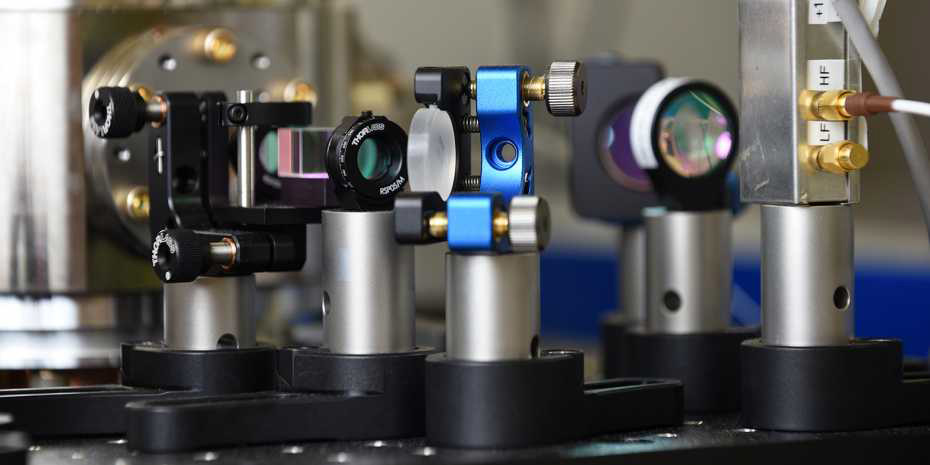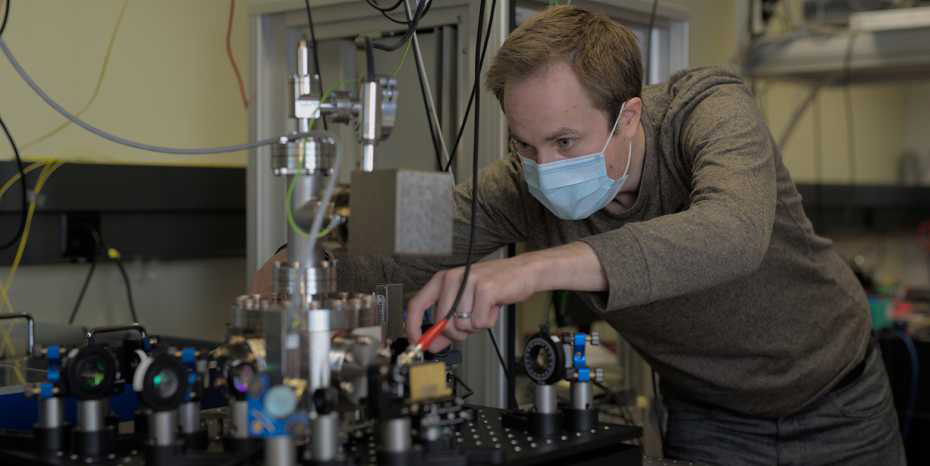
Close-up of optical components used to stabilize the light of an infrared laser for a precise reference frequency. A team of scientists in Switzerland has devised an approach for distributing ultra-precise reference frequencies over existing telecom fiber, potentially enabling a network for international comparison of clock signals. [Image: METAS]
Metrology and standards organizations need to disseminate reference frequency signals with higher resolution than satellite communications can provide. Now scientists in Switzerland—a country known for precise clocks—have developed a technique for sending these signals over a lesser-used spectral band within optical fiber networks.
The collaboration between scientists at four Swiss laboratories demonstrated the transmission of an accurate frequency signal in the L-band of a 456-km optical fiber network, without disturbing the data transmission over the conventional C-band within the fiber (Opt. Express, doi: 10.1364/OE.427921). The technique could, according to the researchers, lead to a new international network for comparing atomic-clock signals and for other applications in particle physics and geophysics.
Satellites get only so accurate
Currently, satellites can distribute reference signals with uncertainties in the 10−16 range. However, cutting-edge projects such as the newest optical clocks operate with relative frequency uncertainties around 10−18. To address that mismatch, metrology scientists could send reference signals over dedicated dark-fiber networks operating in the C-band (1530 nm to 1565 nm), where they could theoretically achieve 10−19 uncertainty levels with off-the-shelf hardware. But leasing dark fiber on a regular basis gets expensive.
Instead, the Swiss researchers set up an optical-fiber ring network connecting three laboratories within the country: the Swiss Federal Institute of Metrology (METAS), the University of Basel and the Swiss Federal Institute of Technology (ETH Zürich). To send their reference frequency signals, they used the L-band (1565 nm to 1625 nm), which is primarily used for network management, while filling the C-band of the same fiber with regular data traffic from the Swiss National Research and Education Network, provided by SWITCH Information Technology Services of Zürich, Switzerland.

Dominik Husmann of the Federal Institute of Metrology (METAS), Switzerland. [Image: METAS]
According to lead author Dominik Hussman of METAS, the scientists applied the well-established C-band technique of optical phase noise cancellation to a new, less congested frequency. This required specific optical components tailored to the L-band, ranging from erbium-doped fiber amplifiers (EDFAs) to optical add–drop multiplexers (OADMs), as well as a specialized phase noise cancellation setup for the network structure.
The technology of the individual components had already existed, of course. But the Swiss team put them together for the first time to distribute a reference frequency within the L-band.
Results and future plans
Before the Swiss researchers did the experiments, they were not sure that the L-band network components would work the same way as their C-band counterparts, Hussman says. Lack of interference between the L-band signal and the C-band data traffic was also not a given.
“Another challenge was the delocalized setup distributed over three laboratories and network nodes,” he adds. “A close collaboration and efficient communication with all project partners, in particular with the network provider SWITCH, was mandatory in order to set up and validate the network in a swift and efficient way.”
Nevertheless, the metrology network transmitted its L-band signal—a frequency measurement of a 729-nm-wavelength laser—with an instability of 4.7×10−16 at 1 s and of 3.8×10−19 at 2000 s, all without interfering with C-band traffic.
“We would like to extend the network to further institutes within Switzerland in order to broaden the access of our metrological frequency to research and industry,” Hussman says. “Further we envision connecting our network with existing networks in neighboring countries, which would allow a direct comparison of primary frequency standards (the most accurate atomic clocks) between metrology institutes.”
The study team included OSA Fellow Jérôme Faist of ETH Zürich and two representatives of the Italian national metrology institute.
